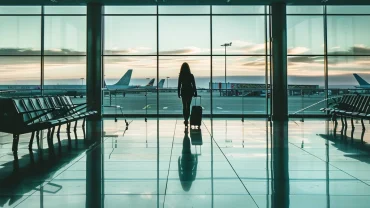The Myth of Cheaper Flight Tickets at Night: Debunking the Common Belief
Introduction:
The quest for finding the best and most affordable flight deals is a perpetual pursuit for avid travelers. Among the myriad of tips and tricks circulating in the realm of travel advice, one common belief stands out: flight tickets are cheaper at night. This notion has been passed down through generations of travelers, leading many to plan their online ticket searches meticulously, hoping to catch a price drop when the clock strikes midnight. However, is there any truth to this widely held belief, or is it just another myth in the ever-evolving world of air travel?
The Origins of the Belief:
The idea that flight tickets are cheaper at night can be traced back to the early days of online flight booking platforms. As the internet became the primary tool for purchasing airline tickets, users began noticing fluctuations in prices at different times of the day. Some speculated that airlines, in an effort to boost ticket sales during slower hours, might reduce prices at night, leading to the popular belief we see today.
The Reality of Airline Pricing:
To understand whether flight tickets are genuinely cheaper at night, it’s essential to delve into the complex world of airline pricing. Airlines employ sophisticated revenue management systems that constantly analyze numerous factors, including demand, seat availability, competition, and historical data. These algorithms dynamically adjust ticket prices in real-time, making it unlikely that there is a specific time of day when prices consistently drop.
Factors Influencing Airline Ticket Prices:
- Demand and Supply: The fundamental economic principle of supply and demand plays a significant role in airline ticket pricing. During peak travel times, such as holidays and weekends, demand is higher, and prices tend to rise. Conversely, during off-peak hours or days, prices may be lower due to decreased demand.
- Sales and Promotions: Airlines regularly launch sales and promotions to attract customers and fill seats. These promotions are not bound by a specific time of day; instead, they are strategically planned and can occur at any moment.
- Dynamic Pricing Algorithms: Airlines employ complex algorithms that consider various factors to adjust ticket prices dynamically. These algorithms operate continuously, making it unlikely that prices will consistently drop at a specific time, such as during the night.
- Last-Minute Deals: While some travelers have reported finding great last-minute deals, these are often unpredictable and can occur at any time. Last-minute discounts are more closely related to factors like seat availability and the airline’s desire to fill unsold seats rather than a specific time of day.
Debunking the Myth:
Numerous studies and analyses have been conducted to investigate the validity of the belief that flight tickets are cheaper at night. However, the consensus among experts is that there is no substantial evidence to support this claim. Airlines operate in a highly competitive market, and pricing strategies are far more intricate than simply reducing prices during specific hours.
Additional Considerations in Airline Ticket Pricing:
- Seasonal Variations:
- Flight ticket prices are often subject to seasonal variations. Airlines adjust their pricing based on factors like weather, holidays, and popular travel periods. For example, during peak vacation times, prices are likely to be higher, while off-peak seasons may offer more budget-friendly options.
- Booking in Advance:
- Another crucial factor influencing ticket prices is the timing of your booking. Generally, airlines tend to offer lower prices for tickets booked well in advance. As the departure date approaches, prices may increase, especially for popular routes.
- Geographical Variances:
- The cost of flying to and from different regions can vary significantly. Factors such as competition, local economic conditions, and government regulations can influence prices. Travelers may find that flights departing from or arriving at specific airports are consistently more affordable.
- Airline Loyalty Programs:
- Many airlines offer loyalty programs and frequent flyer miles that can significantly impact the overall cost of air travel. By accumulating miles through regular travel or credit card partnerships, passengers may have the opportunity to redeem these miles for discounted or even free flights.
- Flexible Dates and Routes:
- Being flexible with your travel dates and considering alternative routes can open up opportunities for more affordable flights. Some online platforms and search engines allow users to explore date ranges, providing a broader perspective on when the most cost-effective options are available.
- Comparison Shopping:
- The importance of comparison shopping cannot be overstated. Different airlines and travel agencies may have varying prices for the same route and class. Utilizing multiple search engines and online travel agencies can help travelers identify the most competitive deals.
- Economic Factors:
- External economic factors, such as fuel prices and geopolitical events, can influence airline ticket pricing. Unforeseen circumstances, like a sudden increase in fuel costs or disruptions in global travel patterns, may lead to price adjustments across the industry.
- Time Zone Differences:
- While the notion of “night” may vary depending on your location, time zone differences also play a role in the perceived idea that tickets are cheaper at night. Prices can change due to market conditions in various regions, but these changes are not necessarily tied to a specific time of day in a universal sense.
More about this:
- Dynamic Nature of Pricing:
- The airline industry operates in a constantly changing environment, with prices adjusting dynamically based on real-time data. Airlines use sophisticated algorithms to respond to market fluctuations, competitor actions, and customer demand. As a result, the notion of a specific time of day dictating lower prices overlooks the intricate, responsive nature of these pricing models.
- Hidden Fees and Charges:
- When searching for flight tickets, it’s essential to be aware of potential hidden fees and charges. Some airlines may advertise seemingly lower base fares but compensate with additional charges for services such as baggage, seat selection, or in-flight amenities. The overall cost-effectiveness of a ticket includes these extras, which may not be evident during the initial search.
- Currencies and Exchange Rates:
- International travel introduces another layer of complexity, involving currency exchange rates. Fluctuations in exchange rates can impact the final cost of a ticket, especially when booking in a foreign currency. Monitoring exchange rates and understanding the implications on pricing can be crucial for travelers seeking the best value.
- The Influence of Booking Channels:
- The platform through which a ticket is booked can also affect the final price. Airlines may offer exclusive deals through their own websites, while third-party travel agencies might have promotions or package deals. It’s advisable for travelers to explore various booking channels to identify the most cost-effective options.
- Evolving Industry Trends:
- The airline industry is subject to evolving trends and innovations that can impact pricing strategies. For example, the rise of budget airlines and the shift towards unbundled pricing (where passengers pay separately for various services) have introduced new dynamics into the pricing landscape. Staying informed about industry trends can help travelers navigate the evolving marketplace.
- Market Competition:
- The level of competition on a specific route significantly influences ticket prices. Higher competition often leads to more competitive pricing as airlines strive to attract passengers. Conversely, routes with limited competition may experience higher prices. Understanding the competitive landscape can be advantageous for travelers seeking the best deals.
- Airline Sales and Flash Deals:
- While not necessarily tied to specific times of day, airlines frequently launch sales and flash deals to stimulate demand. These promotions can offer substantial discounts but are often time-sensitive. Subscribing to airline newsletters, following them on social media, or using dedicated deal-finding websites can help travelers catch these limited-time offers.
- In summary, the quest for affordable flight tickets involves navigating a multifaceted landscape encompassing various factors, from economic conditions to industry trends. The belief that flight tickets are consistently cheaper at night oversimplifies the complexity of airline pricing. Instead, travelers can optimize their chances of finding the best deals by staying informed, being flexible, considering additional fees, and exploring a range of booking channels. As the airline industry continues to evolve, so too should the strategies travelers employ to secure cost-effective and enjoyable journeys.



Comment (0)